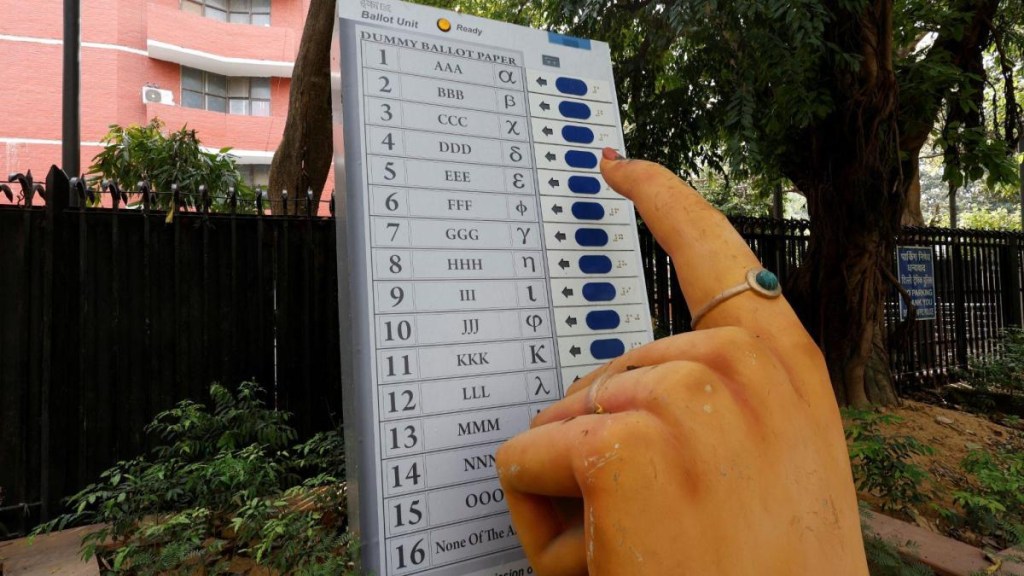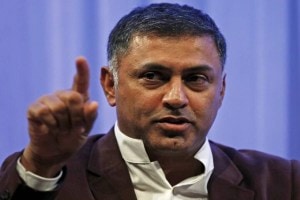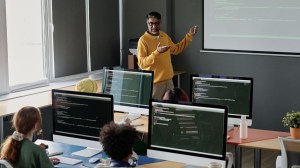At first glance, he may look like just another youngster—complete with a beard and a hoodie—out to have his share of fun on Instagram Reels. But start listening to the video, and you will realise that the native of Bulandshahr in Uttar Pradesh has a serious message to convey.
“On May 7, people in 12 states will stand in queues to cast their votes. Do vote, but remember that the red light that glows after you press the EVM button for BJP will also be a red alert for your mothers, daughters and sisters. Will you be able to accept it?” he asks, gesticulating and emphasising his words with voice modulation.
“In the past 10 years, the BJP government has done many things that need to be questioned,” says Arpit Sharma, the creator of the video and a chartered accountant by profession working in Ireland.
The video, which was shared by the Aam Aadmi Party (AAP) on its social media platforms with a caption in Hindi that said, ‘Do watch this video before casting your vote’, is one of several such made by influencers to criticise political parties, appeal voters to make an informed decision on their choice of candidate or party or simply highlight a pressing issue as the election season gains momentum.
The idea is to make people aware of the “wrongdoings” of the parties or to focus on their “good work”, say the political influencers, or ‘poll-fluencers’ as they are also referred to. The political parties, in turn, are betting on them to swing votes or to amplify their message across audiences.
The relatability factor
Sharma, who earlier worked with a fact-checking website, believes influencers bring in factors such as relatability, along with a bit of satire and quirkiness, and this makes them click with their audiences.
Like Sharma, several other influencers have made inroads into social media feeds, cutting across political lines. While those like Dhruv Rathee, The Ranting Gola and Gaurav Karan Chaudhary are often found criticising the ruling government, finding space in the social media accounts of the Congress and AAP, among others, others like badminton player PV Sindhu, author Amish Tripathi, Kotak Mahindra Bank founder Uday Kotak, journalist Dilip Mandal, JPMorgan CEO Jamie Dimon and spiritual leader Sri Sri Ravi Shankar talk about BJP and PM Narendra Modi’s work.
Influencers help to present politicians in a more ‘humanised’ light, feels Joyojeet Pal, a researcher and associate professor at the University of Michigan, USA, who has worked on a research paper on social media influencers in Indian politics. “In general, as citizens, we only see politicians on stage or in their political form. When we get a chance to see them talking about their food or travel preferences, it gives us a different and more relatable version of the politician. This is useful for the political brand without feeling like an explicit advertisement,” he adds.
As per Ankit Lal, founder of Politique Advisors, a new-age strategic consulting agency based in Noida, each party has a set of core supporters but they are not enough to take them beyond the victory line. “That is where influencers, who have a neutral audience following, become very important. The entire fight is getting the neutral audience to talk about the issues that the party wants to talk about and eventually vote for them. It becomes important in the larger perspective,” adds Lal, who earlier worked as the head of AAP’s IT cell.
Influencers are like human-sized blowhorns with a varied audience making them a perfect medium for government or political parties to leverage. For example, a youth might skip a full-page ad on a government scheme but he or she is likely to notice if it is subtly talked about in a language or expression relatable to them, from someone they know on social media.
As such, even the Election Commission of India (ECI) has not been able to ignore the role of influencers during the elections. For instance, cricketer Sachin Tendulkar has been roped in to urge people to vote for the 2024 Lok Sabha polls. “Motivation of voters through influencers and brand ambassadors and youth icons has been a regular activity of the voter education division from its inception in 2010. It has been effective,” former chief election commissioner SY Quraishi told FE.
He, however, clarifies: “We just have to be careful that they are non-partisan.”
‘Non-partisan’ is the key word. “Collaborating with brands is commercial but with political parties, their ideological thought process becomes visible,” says Arpit Sharma, who refrains from working with a political party for the same reason. “We become a part of the problem that the party’s ideology has. We, too, have some social responsibility,” he adds.
On parties such as the AAP and Congress sharing his videos, he says, “I will gain a few more followers as their reach is far more. In the past, too, the Youth Congress shared my video but didn’t give any credit.”
Like Sharma, Rathee and Chaudhary, too, were approached by parties but they refused to work with them. They cited reasons like being wary of their image online, political affiliation impacting their brand, and ethical concerns. “I don’t want to do political associations because I will have to compromise my stand and my values. I will be judged ‘anti’ or ‘pro’ and I don’t want to go into that category,” says Chaudhary, a 35-year-old Faridabad-based social media creator, currently pursuing law to enhance his knowledge base for his explainer videos. “I personally believe when you are in a medium where you share information for people, there should not be conflict of interest. It is more of a moral stand. You should give a complete picture and that’s a core responsibility of every creator who is creating videos on any such issue,” Chaudhary says, adding: “When you associate with such a political group, you tend to ignore their cons and that is a kind of brainwashing.”
Assembly to Lok Sabha
While the 2024 general elections are being touted as ‘social media elections’, influencers’ collaboration with parties or videos supporting or criticising any party or candidate is not a new phenomenon.
State governments across party lines in Rajasthan, Madhya Pradesh, Chhattisgarh and Telangana, among others, have been meticulously strategising and reaching out to influencers for “better accessibility” of the government’s social welfare schemes in the wake of Assembly elections.
For instance, in the run-up to the Madhya Pradesh elections last year, the BJP tapped regional influencers like Chandani Bhagat and Samyak Jain for hyper-local reach. Bhagat told FE that she made videos for the BJP on their women-centric schemes like Ladli Behna Yojana because she thought this would help her audience.
Bhagat says she makes videos on Sanatan Dharma so that “today’s youth don’t go astray.”
“For those who love me on social media, my objective is to take them towards dharma and share with them useful information. So I made videos on the government’s yojana as there are some followers who are only 10th-12th pass but want to work and are looking for a job,” Bhagat says.
Bhagat was among the 150-200 Indore creators who met then CM Shivraj Singh Chauhan ahead of the last Assembly elections. “We were told about government schemes and policies and how to promote them. Creators of Indore who had over a million followers went there,” she says.
Jain, 23, another Indore-based influencer, was also among those participants. Jain told FE that he made videos for the BJP because the party “is in trend”. He also says he identifies with the party’s ideology and has “good relations” with local leaders.
While the BJP has been managing the influencer campaign in the past one year leading up to the 2024 general elections under the larger ‘nine years of Modi’ campaign, the Congress has been approaching regional influencers because of its ‘limited resources’, sources told FE.
During the Bharat Jodo Yatra, Congress leader Rahul Gandhi gave interviews to Kamiya Jani of Curly Tales, Kunal Vijayakar of Khaane Mein Kya Hai and Samdish Bhatia of Unfiltered by Samdish. In Rajasthan, the Congress government had announced last year that it will give ads to influencers ranging from Rs 10,000 to Rs 5 lakh.
In Telangana, ahead of Assembly polls last year, Bharat Rashtra Samiti engaged over 250 influencers for surrogate promotion of the party seeking reelection.
In Chhattisgarh, the Congress enlisted Youth Congress members to act as influencers. Ahead of the Assembly elections last year, BJP roped in influencers across the nation and instructed them not just to post but to perform in the videos. “When you are hiring them, you can dictate terms. Then you prepare the questionnaire. Questions can be fixed even in media interviews but if you are paying someone, only you will tell them what to ask,” says Amitabh Tiwari, an election analyst and commentator.
Partyspeak
In the past one year, BJP has strategically tapped influencers for electioneering. Talking about this digital campaign, Devang Dave from the party’s election management committee in Maharashtra says, “BJP planned various social media meets across the country in the past one year. While it happened centrally, influencers from across states and parliamentary consultancies were invited. We told them what the government has done over the past nine years and how its initiatives have transformed everybody’s life. We asked them to showcase real-life stories and create their own content in which they believe how their own life has changed.”
This gives credibility, says Dave. “It creates a lot of trust among the citizens when a third person who is an independent influencer speaks well about our schemes and their implementation,” he explains, adding how most of these influencers are “admirers of PM Modi” who “make videos on their own” because they “want to do their bit in the campaign”.
The Congress, on the other hand, started roping in influencers during its Bharat Jodo Yatra. Vaibhav Walia, chairman of the party’s ‘communications war room’ for 2024, says, “There were a lot of influencers who reached out, joined the yatra and interacted with Rahul Gandhi. Later on, we realised that it’s a good effort and we continued it.”
The grand old party has been mostly working with regional influencers, with an influencer management unit in place as part of its communication strategy.
Talking about how the party has been approaching the influencers, Walia claims, “If you look at the big guys, Dhruv Rathee shared Rahul Gandhi’s video and Ravish Kumar has been sharing thoughts on us. They are doing it voluntarily. If they reach out to us for any content or any support, we are happy to give them but they’re mostly doing it on their own.”
Expanding on what the party tells the influencers who reach out to the party, he says, “We tell them about the content they can post for us, about any video that Rahul ji has done or any issue he has spoken about or we need some support for. When Bharat Jodo Yatra was on, we would tell them we were travelling from their area and whether they could talk about it.”
“We are doing all of that as part of our efforts but this is voluntary and people are coming in with their support,” he claims.
Walia, however, is concerned about influencers trying to “sail in both ships”. “It becomes a little tricky and embarrassing. Ideally, we would want the influencers to stick to one side. That way, they will have more credibility, but you can’t control these things,” he adds.
According to Walia, the party, however, doesn’t give its time or engage with extreme right-wing influencers. “So, we do some testing and background checks. If somebody is posting or trolling RG in the past or posting extreme right-wing content or hateful content, we don’t engage with them,” says Walia.
Walia also says that the Congress’ influencer strategy is regional. “BJP, on the other hand, is doing well nationally because they have a lot of money and power. Modi did creator awards from the government. That was an influencer management show which the government organised for the party which is a clear misuse of government resources,” he adds.
Meanwhile, the AAP, which came into being riding on the power of social media during the India Against Corruption movement, says that even though its strategy for social media influencers is not quite a part of the larger election campaign, they are being done in the 2024 elections on an experimental basis.
Ritik Gupta, AAP’s Delhi social media coordinator, told FE that the influencers who are creating videos for the party share their ideas with them, show them the demo and they ask them to make corrections, if any, such as “offensive words”. “The influencers and our team work in coordination for approval,” he says, adding: “We don’t give any benefit to anyone. We just give them ideas or content.”
“They come to us because of ideology, and how things are working in Delhi and Punjab. We have all kinds of influencers, even those whose follower count is average but content is good,” he explains.
The AAP’s strategy is only to convey its message to the public, says Gupta. “We tell them that positive campaigning should be done. We want to talk about our work.”
While they are self-motivated to share information among the public, Gupta admits that they seek publicity too, and influencers are wary of their audience. “Influencers have their choice. Usually, if they are working with another party, they don’t come to us because they can even be trolled,” adds Gupta, who has been working with the party since the last assembly elections in Delhi.
Reel or real impact?
Experts share mixed opinions on the impact of influencers during elections. Pal of the University of Michigan says their ‘influence’ will differ nationally and regionally. “Influencers often operate at the national level and their fans are rarely restricted to a single geography. Therefore, the goal of the interviews with influencers is to move the direction of the narrative in a preferable direction, rather than to immediately influence votes,” he explains.
So, can these interviews get converted into votes? Pal believes micro-influencers have a stronger viability as their appeal is valuable to a specific small region.
Election analyst Tiwari believes influencers don’t have the potential to make any difference in terms of shaping opinion online. “When people see the programmes by influencers, they are smart enough to figure out that these are paid promotions. I don’t think it has any significant impact,” he says, emphasising that it’s a “hygiene factor” as “one party does this, another has to also do it to counter this and neutralise this but there’s no benefit”.
Senior journalist Herjinder Singh Sahni, in his book The Deception Industry: The Art, Craft and Science of Hacking the Electorate, however, writes that joining election campaigns can make them be seen with the party label. “Political parties are not products, and political affiliation in an emotionally polarised society might cause future difficulties for some influencers. However, individuals developing election strategies never think about the long term,” he adds.
Why politicians turn to influencers
In his new book, The Deception Industry: The Art, Craft, and Science of Hacking the Electorate, published by Rupa Publications, journalist Herjinder Singh Sahni writes: “Now, many social media stars find advantages in associating with politics. They believe that if political figures join them, their following will grow rapidly. This has also occurred. Politicians see this as a lucrative deal in many ways. For example, for interviews, such influencers are chosen who do not ask very difficult questions or raise counter-questions on any answer. Giving interviews to mainstream media journalists may pose both of these risks.”
YouTuber Dhruv Rathee thinks influencers are filling the gap created by TV news channels. “Political parties want to tap the young audience who don’t watch TV news,” he says. This division between a TV audience and a social media audience was recently elaborated during a YouTube show of a digital news website, when a Hindi TV news channel journalist said: “Those who support the BJP, watch TV news, and those who don’t like the government, watch social media.”
Ankit Lal, founder of Politique Advisors, says many politicians prefer to engage people running smaller platforms on a one-to-one basis because it becomes a symbiotic relationship in some sense. Influencer Samyak Jain from Indore talks about having “good mutual connections with local leaders” as reasons for working with them, but emphasises he has “no commercial angle”. “We have good connections with local IT cell people. The BJP is in trend and if we are supporting them, their followers will come to us. We will get more local following,” Jain tells FE.
Lal of Politique Advisor says larger political organisations manage different influencers on various levels. “There are ideologically aligned influencers, and there are in-house influencers. Then there are open market influencers who are available in a kind or mercenary format. All of them need to be dealt with differently,” he explains.
A Congress party worker told FE that they managed influencers during the Bharat Jodo Yatra because they felt not enough coverage was being given by TV news channels.
Shaleen Mitra, a social media influencer working with AAP for the past 13 years, says volunteering is “good enough”. Mitra has worked with several party ministers such as Manish Sisodia, Saurabh Bhardwaj and Atishi on projects such as mohalla clinics, public grievance monitoring, website like ‘AAP ka Ram Rajya’ and assisting them in electioneering. In this general election, he has been assisting Atishi on ground in electioneering.
Mitra says he doesn’t have any political aspirations and the party doesn’t give him “any money or resources”. Pursuing a PhD in psychology, he wishes to build his online brand in the intersection of political science, sociology and psychology. “I talk about the life of politicians. We do talk about their aspirations for political reform, but I want to show people that leaders are not extraordinary people. Their passion for service and public life is what makes them what they have become. I want to show the human side of the leaders, their candid side,” he adds.
The big influence
- India’s influencer marketing industry to rise to Rs 34 billion by 2026, from Rs19 billion in 2023
- Instagram, YouTube most popular platforms
- Micro and regional influencers gaining traction
- In terms of social media reach and presence, BJP on top with 23.54%, ahead of Congress, AAP & TMC combined








